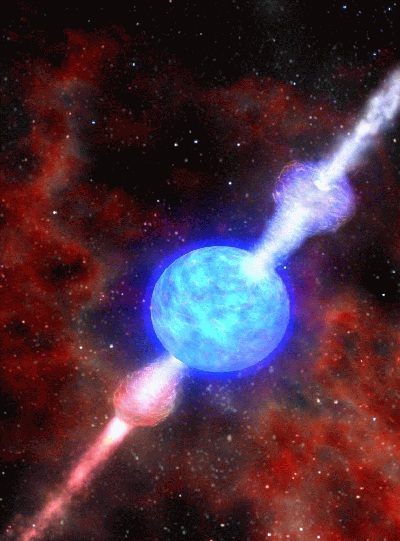Gamma-ray burst jets in type Ib/c supernovae
|
A. M. Soderberg (California Institute of Technology, USA); D. A. Frail (National Radio Astronomy Observatory, USA) and M. H. Wieringa (ATNF) As the most luminous objects in the Universe, gamma-ray bursts (GRBs) have grabbed the attention of both astronomers and the public. However, during the 31 years since the discovery of gamma-ray bursts, the nature and origin of these powerful collimated explosions has remained largely unknown. Recently, with the discovery of a relatively nearby gamma-ray burst event on 29 March 2003, known as GRB 030329, spectroscopic observations have provided undeniable evidence that long-duration gamma-ray bursts originate from supernovae (SNe) explosions that follow the end of nuclear burning and core collapse in massive stars. The first important observational clue that there is a link between gamma-ray bursts and the deaths of massive stars came in April 1998. Responding to a new gamma-ray burst, GRB 980425, astronomers found to their surprise an ultra-luminous Type Ic supernova, SN 1998bw, coincident with the satellite position, but located a mere 40 million parsecs away! Based on Compact Array observations, SN 1998bw was shown to be an unusually energetic supernova with properties similar to those observed in cosmological gamma-ray bursts, thus bolstering the idea that the two explosive events were related. However, while the Compact Array observations strengthened the link between gamma-ray bursts and stellar death, it produced its own puzzle: What is the connection (if any) between GRB 980425 and the much more distant cosmological gamma-ray bursts? Despite being the nearest burst detected to date, the afterglow emission from GRB 980425 was under-luminous compared to all other gamma-ray bursts. Afterglow emission is produced by particle acceleration within the collimated gamma-ray burst ejecta (jet) as it sweeps up and shocks the interstellar medium. During the six years since the event of GRB 980425 the radio afterglow has been monitored with the Compact Array (Kulkarni et al. 1998). The most recent measurements in, December 2003 by Soderberg and her colleagues, showed that the radio emission continues to decay as a power-law. These recent data are of extreme importance in determining the relation between GRB 980425 and other gammaray bursts. One popular theory posits that GRB 980425/SN 1998bw was a typical gamma-ray burst viewed far away from the collimation axis of the jet. In this scenario, the afterglow emission is initially beamed away from us and therefore appears sub-luminous. However, as the gamma-ray burst jet decelerates it begins to spread sideways and eventually reaches spherical symmetry on a timescale of one to ten years, depending on the density of the surrounding medium. When the jet spreads into our line-of-sight it should produce a sharp rise in the observed radio afterglow emission. However, six years after the burst, the Compact Array observations do not show any evidence for a sharp rise in the radio emission and thus no evidence that GRB 980425 was initially pointed away from our line-of-sight. This result was combined with upper limits for 15 local (less than 100 million parsecs) type Ibc supernovae between one and 20 years old to show that at most six per cent of local SNe have associated gamma-ray burst jets. An alternative to the off-axis jet hypothesis considers the event of GRB 980425/SN 1998bw as a member of a separate class of sub-energetic explosions characterised by fainter afterglow emission. This theory is supported by the recent event, GRB 031203, the nearest burst besides GRB 980425, which similarly showed a sub-luminous afterglow and association with an ultra-luminous type Ic supernova (SN 2003lw). With the launch of the NASA spacecraft SWIFT in late 2004, to search for gamma-ray burst events, it is anticipated that a significant population of similar local sub-energetic gamma-ray burst events will be revealed. |
|

